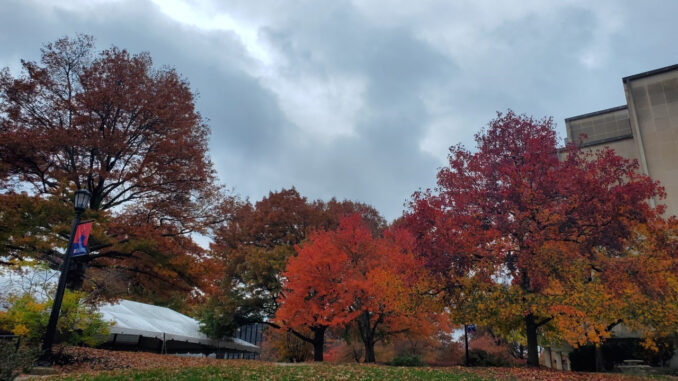
Zach Petroff | Opinions Editor
March 30, 2023
With the start of spring last week, it will be a matter of time before students can bask in the shade of one of the many trees on campus. Even with Duquesne’s University urban environment, the campus has 530 trees on campus, with 37 more to be planted in 2023.
For the second year in a row, Duquesne received the annual Tree Campus Higher Education recognition from the Arbor Day Foundation. This award is part of the university’s commitment to establish several long-term environmental and sustainability goals.
“I think it shows that we care about the place where we are living and learning,” said executive member of Duquesne’s Evergreen Environmental Club, Rebecca Ulinski. “As students, we can help trees and all plants and wildlife around campus by not littering, not pulling on branches and showing up to plantings and cleanups that are hosted around campus.”
In order to be recognized by the Arbor Day foundation, the university had to satisfy five criteria such as the establishment of a campus tree advisory committee, evidence of a campus tree care plan and creating a service-learning project aimed at engaging the student body.
“When I came in, I had been doing this for the past 10 years at my former university,” said Kristen Spirl, ground supervisor and major contributor to Duquesne’s tree campus status. “So when I got here, I already knew the previous ground supervisor. Everything was already done. I just pulled everything together into one nice shiny package and sent it over to the Arbor Day foundation for them to consider.”
The implementation of campus landscape and green infrastructure projects is part of the university’s master plan of sustainability initiatives, which include prioritizing and improving campus green spaces.
According to Spirl, the existing canopy of leaves, branches and stems of trees that cover the ground when viewed from above is at 10.5% and covers about 5.23 acres. The goal is, in 10 years, to have the canopy expand to 15.2% which would cover about 7.5 acres.
Due to the city’s requirements, a tree inventory on campus was needed to account for all trees and their quality on campus. In 2019, the university had 510 trees on campus.
There are 69 varieties of trees at Duquesne, ranging from the common white spruce to the endangered Japanese maple. With the wide variety of trees, the grounds crew are aware of the unique challenges that come with keeping the forestry healthy.
“The campus has a lot of mature trees that are 80 years old,” Spirl said. “We only have a few that are in very good health. Some of the other ones have started to decline.”
Many factors, such as the change in environment, can bring harmful elements that make it hard for trees and plant life to adapt.
“When they are unable to adapt to flooding, they get sick and that makes it easier for different pathogens or bugs to make their way in,” Spirl said.
Not only do trees provide the oxygen that we breathe and a comfortable place for students to study, the university has been able to utilize some of the trees on campus for charitable purposes.
In October, Spiritan Campus Ministry’s program, All Hands for a Cause, picked apples from the trees next to Rangos.
The idea was inspired by one of the priests when he noticed how delicious the apple trees on campus were during a walk, recalled Deborah Kostosky, Spiritan campus minister.
“We came up with the idea to use them to make applesauce,” Kostosky said. “It was an easy, one-time service project we could offer to students which is the main idea behind All Hands for a Cause.”
Supplementing with additional apples from a local farm, the students partnered with the Laval House kitchen to make applesauce and distribute it directly to the homeless population Downtown through Duquesne’s chapter of the Society of St. Vincent de Paul.
Considering the future was a common theme among campus organizations concerned with the environment.
“There are endless opportunities for students to help the environment on campus,” said Brynn Tripp, freshman Evergreen executive board member.
“Being involved with clubs and organizations that strive for a more sustainable community is a great way to put our care for the Earth into action. The simplest actions and ideas have a strong impact,” she said. “Staying educated about current environmental issues around the globe sparks conversations about our world.”

